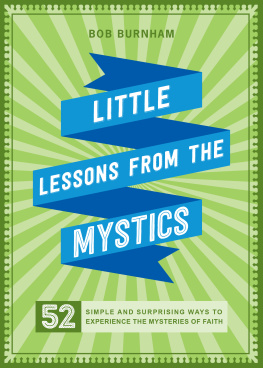Cathy, this is your fault.

3441 N. Ashland Avenue
Chicago, Illinois 60657
(800) 621-1008
www.loyolapress.com
2017 Bob Burnham
All rights reserved.
Scripture quotations are from New Revised Standard Version Bible: Catholic Edition, copyright 1989, 1993 National Council of the Churches of Christ in the United States of America. Used by permission. All rights reserved worldwide.
Cover art credit: cristinabagiuiani/iStock/Thinkstock, Shutterstock
eBook ISBN: 978-0-8294-4502-2
Based on the print edition: 978-0-8294-4501-5
Library of Congress Control Number: 2016958342
17 18 19 20 21 EPUB 5 4 3 2 1
While he was recovering from a battle wound, Ignatius of Loyola asked for some books to read. He was probably hoping for tales of romance and knightly valor. Instead, he received The Life of Christ by Rudolph of Saxony and Flowers of the Saints. As he readand rereadthese books, he asked himself, What if I should do what St. Francis did? Over time, he began to forget about his dreams of military adventure and courtly love and sought to imitate the lives of the saints.
You could say he had saints on the brain.
I, too, have saints on the brain. They are my teachersthey show me how to live as a disciple of Christ. Like St. Ignatius, the lives of the saints inspire me to ask the question, What if I should do as they did?
We are called to imitate the saints because we are called to be saints. But heres the secret: we are already saints, albeit imperfect ones, for Christ lives in us, and we live in Christ. The saints teach us how to see that truth more clearly.
Pope Francis reminds us that always, in every place, one can become a saintthat is, one can open oneself to this grace, which works inside us and leads us to holiness. The lessons and meditations in this book are meant to help us open ourselves to such grace so that we can be living saints.
When we recognize our own sanctitywhen we realize that we can be saints today, in the ordinariness of our liveswe can live out the promise of the gospel and realize that the kingdom of heaven is a present, if incomplete, reality.
Inspired by such hope, we can effect change for the better.
Lessons, Not Lives
I do not pretend to offer another collection of saintly biographies. I am not a scholar, a historian, or a theologian. I am just a regular guy who takes seriously the counsel of St. Teresa of vila: We need to study, to meditate upon, and to imitate those who, mortals like ourselves, performed such heroic deeds for God.
Every year in my faith formation classes, I ask my students to research a saint. I offer them print and online resources and invite them to share the results of their research. What follows is usually an uninspired report that includes some facts about the saint, such as when and where he or she was born, when the saints feast day is, and maybe a few interesting anecdotes from that saints life.
So what? I end up asking. In all that you read about this saint, what about them inspires you? What do they tell you about following Jesus Christ?
These are the critical questions that we often forget to answer when we read about the saints. We admire them from afar, like the statues that decorate our gardens and churches. We venerate them; we might pray to them to find a lost item; we might ask them to pray for our loved ones who need healing or protection. But how often do we think of them as active, living teachers? How often do we ask the question that St. Ignatius asked all those years ago: What if I should do as the saints did?
In the pages that follow, I offer one small lesson from the lives of fifty-two different saints, along with a brief meditation based on that lesson. As you spend time with a saint, you will learn how to apply that saints particular charism to your life so you can do what they did, but in your own unique way.
You can use this book any way you want!
But thats not really helpful. So here are some basic guidelines.
Spend a week with one saint. Choose a regular time to sit with one saint for a week and meditate on that saints lesson using the steps provided. Meditate at the same time and in the same place each day with the same saintdoing so helps develop discipline, which is extremely beneficial to ones spiritual life. As the week progresses, you may find the meditation leading you into a deeper conversation with God. Over the course of a year, you would have spent time with fifty-two saints on a journey toward your true selfthat is, the Christ who dwells in you.
Meditate. Each meditation is as long as it needs to be, but I recommend five to ten minutes to begin with. These meditations draw on Ignatian spiritualitythat is, the spirituality developed by St. Ignatius of Loyola in the Spiritual Exercises. By reflecting on our personal experiences and comparing them to the life of Christ and the lives of the saints, we will be able to discern what God wants for us.
Each meditation follows the same format:
Centering. Spend a minute or two settling your mind. A brief Scripture verse is offered to help you calm your mind.
Reflection. The meditations draw on your life experiences to help you think about how to apply an aspect of the saints lesson. One of the great gifts of Ignatian spirituality is its understanding that God can be found in all things, especially in the events of everyday human experience and the thoughts and feelings that surround them. Thus, the reflections often ask you to pay attention to your emotions.
Conversation. Another characteristic of Ignatian spirituality is the practice of talking to Jesus. St. Ignatius advises us to talk to Jesus as we would talk to our closest friend. God desires authenticity, so in this part of the meditation, tell Jesus whatever is on your mind and listen carefully for his response.
Prayer. Each meditation closes with a prayer to the saint, asking him or her to intercede on your behalf. Of course, you may substitute this prayer with one of your own choosing.
Begin at the beginning. The saints are presented in a specific order and organized into chapters as follows:
Surrender. The spiritual journey begins when we surrender our will to Gods will, when we can say, as Mary said, Let it be with me according to your word. (Luke 1:38) The saints presented in this chapter provide instruction on how to do that, and the meditations provide practice in surrendering to God.
Freedom. Once we have surrendered everything to God, then we can be poor in spirit. We are free to begin the pilgrimage of love without carrying anything of our own, except an open heart and an open hand. The saints presented in this chapter offer lessons on developing this sense of freedom to love God, others, and yourself. Following this theme, the meditations are essentially acts of liberation.
Pilgrimage. We are all on a journey home toward our Father in heaven. Yet we can get lost along the wayafter all, journeying with God can be like walking in a fog at night. The saints are with us on this journey, and they give us useful advice on how to walk the walk. These meditations lead us to our true selves, that is, the person whom God imagines us to be.
Hospitality. Because we are wanderers, we know the value of welcoming others. The saints in this chapter tell us about the importance of welcoming the stranger into our hearts. These meditations are designed to help you develop a sense of hospitality.












